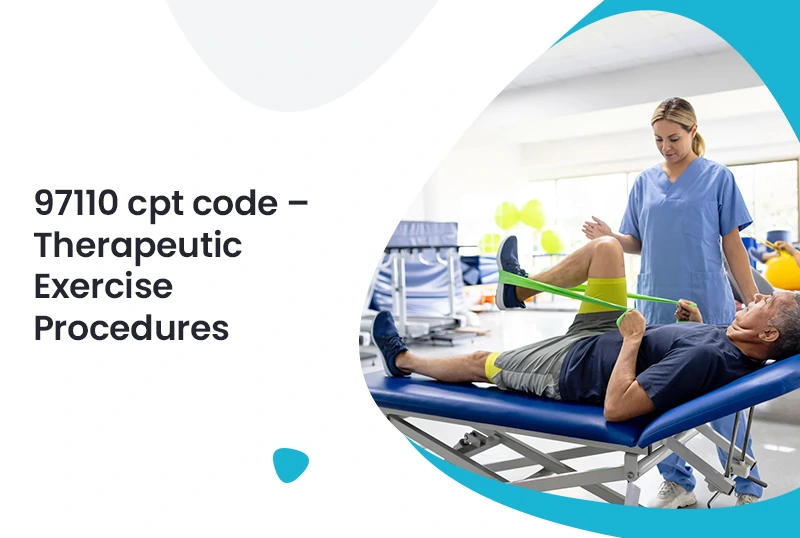When billing for therapeutic exercises in physical therapy, understanding the 97110 CPT code is crucial. At medical billing company, our team ensures accurate claims and timely reimbursement by closely following coding guidelines. Physical therapists rely on this code to document one-on-one exercise sessions tailored to improve strength, flexibility, and range of motion. Misapplying or misinterpreting this code can lead to claim denials, delayed payments, and compliance issues that impact both practice revenue and patient satisfaction. A clear grasp of 97110 CPT code requirements streamlines billing workflows and supports optimal patient outcomes.
The 97110 CPT code represents the procedure for therapeutic exercises focused on restoring or improving neuromuscular functions. When you deliver targeted exercises—such as resistive strength training, range-of-motion drills, or balance training—you document each session under 97110 CPT code. Payers like Medicare, Medicaid, and many private insurers correlate reimbursement rates to properly coded services. Billing this code accurately demands more than just ticking a box; you must detail the exercise type, duration, and patient response. Implementing LSI phrases such as “physical therapy billing,” “therapeutic exercise procedure,” or “rehabilitation therapy coding” can help reinforce content relevance and support proper claim adjudication.
What Is the 97110 CPT Code?
The 97110 CPT code covers therapeutic exercises designed to address deficits in strength, endurance, balance, or range of motion. These face-to-face sessions require a qualified therapist—such as a physical therapist or occupational therapist—to deliver and supervise exercises. Examples include:
- Resistance Training: Using weights or resistance bands to improve muscle strength.
- Stretching Protocols: Targeting tight muscles and improving flexibility after injury or surgery.
- Neuromuscular Re-Education: Activities that retrain movement patterns, especially important for patients recovering from stroke, neurological disorders, or orthopedic surgery.
- Balance and Coordination Drills: Exercises to prevent falls and improve stability, often critical for older adults or those with vestibular conditions.
Read more here: Billing and Coding Services for Somerset Family Practice: What to Expect
Providers must document each element thoroughly. A note like “Patient performed resistive knee extension exercises for 15 minutes to improve quadriceps strength” demonstrates compliance. Proper application of the 97110 CPT code on claims ensures payers recognize the medical necessity of therapeutic interventions, reducing audit risk and boosting practice revenue.
Indications for Using 97110 CPT Code
The 97110 CPT code applies when:
- A skilled therapist administers one-on-one exercise sessions to address neuromuscular or musculoskeletal conditions.
- Exercises target functional limitations—for instance, walking after hip replacement, improving grip strength post-hand injury, or enhancing posture control after spinal surgery.
- Sessions meet minimum time thresholds—Medicare typically requires at least eight minutes of direct treatment for a single unit.
Common clinical scenarios include:
- Post-Operative Rehabilitation: Following joint replacements or ligament repairs, tailored exercises restore function.
- Neurological Rehabilitation: For stroke survivors, controlled exercises improve gait and coordination.
- Chronic Pain Management: Strengthening and flexibility drills reduce pain in conditions like osteoarthritis or chronic low back pain.
- Sports Injury Recovery: Athletes recovering from ligament sprains or tendinitis benefit from progressive resistance training.
Use 97110 CPT code when you can clearly tie each exercise to patient-specific goals—such as increasing knee flexion from 60 to 90 degrees or improving single-leg balance from 10 to 30 seconds. Documentation must include objective measures to justify medical necessity and confirm you provided a skilled service.
Documentation Requirements
Accurate records underpin successful billing for 97110 CPT code. Every note should include:
- Type of Exercise: Specify the exercise—e.g., “Therapeutic resistance band exercises targeting gluteal muscles.”
- Duration: Record time in minutes—e.g., “20 minutes.”
- Intensity and Progression: Document resistance levels or repetitions—e.g., “Performed 3 sets of 10 repetitions with moderate resistance.”
- Patient Response: Note improvements or limitations—e.g., “Patient reported decreased pain during extension and improved overall range of motion.”
- Goals and Outcomes: Tie exercises to functional objectives—e.g., “Goal: Ambulate 100 feet without assistive device.”
For example, a compliant note might read:
“Patient performed seated knee flexion and extension using resistance band for 15 minutes. Achieved 10% increase in knee flexion compared to prior evaluation. Goals include improving quadriceps strength to facilitate stair climbing.”
Incomplete or vague notes often lead to claim denials. For instance, simply writing “Therapeutic exercise – 20 minutes” fails to specify the type or medical necessity. Thorough documentation removes ambiguity, supports 97110 CPT code usage, and demonstrates compliance during audits.
Payer Policies and Reimbursement
Reimbursement policies for 97110 CPT code vary widely:
Medicare
- Requires at least eight minutes of direct, one-on-one therapy for a single unit.
- Uses the “8-minute rule”:
- 8–22 minutes = 1 unit
- 23–37 minutes = 2 units
- 38–52 minutes = 3 units, and so on.
- 8–22 minutes = 1 unit
Medicaid
- Often follows state-specific guidelines; some states allow concurrent treatment only under specific conditions.
Private Insurers
- Each payer sets its own reimbursement rates and documentation criteria.
- For example, some commercial payers require supporting diagnoses—such as ICD-10 code M17.11 (Unilateral primary osteoarthritis of knee)—to justify medical necessity.
Staying current on payer-specific policies is essential to avoid underpayment. Consider outsourcing credentialing tasks to specialized medical credentialing services that maintain up-to-date contracts and fee schedules. These partners can also assist with re-credentialing, ensuring your practice remains in-network with major payers.
How to Maximize Reimbursement and Avoid Denials
Maximize reimbursement through precise documentation and strategic billing:
- Align Services with Functional Goals
Clearly link exercises to patient outcomes. For example:
“Therapeutic exercise 97110 CPT code used to improve shoulder abduction by 15 degrees to facilitate overhead reaching.” - Use LSI Phrases
Incorporate terms like “strengthening exercises 97110 CPT code,” “therapeutic exercise time requirements,” and “physical therapy billing best practices” in notes and educational materials for staff training. - Avoid Unbundling and Upcoding
Do not bill 97110 CPT code for group sessions or wellness activities. Group exercise must use separate group codes (e.g., 97150). Upcoding to supervise home exercise programs wrongly triggers audits. - Monitor Time-Based Billing
Document exact minutes of each service. If a session lasts 38 minutes, bill two units (each unit represents 15 minutes after the initial 8-minute threshold). - Implement an Audit Process
Regular peer reviews of charts identify inconsistencies. Internal audits before claim submission minimize errors, reduce denials, and improve cash flow.
Common Mistakes to Avoid
When billing 97110 CPT code, watch for these pitfalls:
- Applying to Group Sessions
Using this code for group therapy violates billing rules; group exercise should use code 97150. - Vague Documentation
Failing to specify exercise type, duration, or patient progress often triggers denials. - Inconsistent Time Tracking
Under- or over-reporting minutes can cause underpayment or raise red flags during audits. - Incorrect Provider Credentials
Only licensed therapists (PTs or OTs) can bill 97110 CPT code. Students or aides require direct supervision but cannot bill independently. - Missing Medical Necessity
Do not bill when exercises lack clear clinical rationale. Always link sessions to documented functional impairments.
Adopting a proactive approach—through staff training and consistent documentation templates—eliminates many common errors.
Benefits of Accurate Coding
Accurate use of 97110 CPT code translates to:
- Financial Stability
Fewer denials and faster reimbursements lead to reliable revenue streams. - Compliance Assurance
Well-documented notes reduce audit risks and protect against fraud allegations. - Enhanced Patient Care
When billing is transparent and streamlined, therapists spend more time focusing on outcomes rather than administrative tasks. - Data-Driven Insights
Tracking utilization of therapeutic exercise codes helps identify trends—such as average therapy duration and outcomes—enabling better clinical decision-making.
Moreover, partnering with an expert medical billing coding firm ensures your practice maximizes reimbursements, minimizes denials, and maintains compliance. These partnerships often include regular training, software updates, and ongoing support to keep your team aligned with evolving payer guidelines.
FAQs (Frequently Asked Questions)
1. What qualifies as therapeutic exercise under 97110 CPT code?
Therapeutic exercise includes one-on-one activities designed to improve strength, flexibility, endurance, or balance. A licensed therapist must supervise and document each exercise’s type, duration, and patient response.
2. How many minutes equal one unit of 97110 CPT code?
Most payers follow the “8-minute rule.” Eight to 22 minutes equals one unit, 23 to 37 minutes equals two units, and so forth. Always verify specific payer guidelines to bill accurately.
3. Can 97110 CPT code be billed for group sessions?
No. Billing 97110 CPT code for group therapy violates coding rules. Use code 97150 for group therapeutic exercises with multiple patients.
4. Which providers can bill 97110 CPT code?
Licensed physical therapists (PTs) or occupational therapists (OTs) can bill this code. Therapy assistants or aides must be directly supervised by a licensed therapist; they cannot bill independently.
5. What documentation supports medical necessity for 97110 CPT code?
Notes should include a clear diagnosis (e.g., ICD-10 code M54.5 for low back pain), specific exercise details, patient’s functional limitations, goals, and progress metrics. This justifies clinical need and supports reimbursement.







